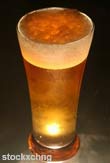Super Bowl Party Science: How to Ration Snacks and Beer

Editor’s note: The story below includes research from Brian Wansink. On Sept. 20, 2018, Wansink resigned from Cornell University, after an internal investigation found that he had "committed academic misconduct in his research and scholarship, including misreporting of research data, problematic statistical techniques, failure to properly document and preserve research results, and inappropriate authorship," according to a statement from Cornell University Provost Michael Kotlikoff.
If your Super Bowl party is too popular and you fear running out of snacks and ale, break out smaller bowls and tall, thin glasses.
Researchers invited 40 college graduate students to a Super Bowl party last year and served them roasted nuts and Chex Mix from one of two buffet tables.
One table had two big bowls of the snacks. The other had the same amount and type of snacks split into four small bowls.
Super eaters
Those who took from the large bowls ate 56 percent more than those who munched from the smaller bowls.
The difference: 142 calories.
Get the world’s most fascinating discoveries delivered straight to your inbox.
"The size of serving bowls provide a subtle cue of how much we should eat," says Brian Wansink, a Cornell University marketing professor who led the work. "A handful of Chex Mix from a large bowl doesn't seem like enough, but one from a medium bowl seems just about right."
The study was reported last year in the Journal of the American Medical Association.
Wansink sees a useful flip side to the tactic:
If you want your family to eat more carrots or other healthy snacks, put them in bigger bowls.
How to pour
When it comes to rationing the beer, you'll need to adjust your tactics.
In a study reported last month, Wansink and colleagues found that bartenders unintentionally pour 20 to 30 percent more booze into short, squat glasses than into tall, thin ones.
"Yet, people who pour into short, wide glasses consistently believe that they pour less than those who pour into tall, narrow glasses," Wansink said.
Another test done with college students pouring their own drinks had similar results.
"People generally estimate tall glasses as holding more liquid than wide ones of the same volume," he said. "They also focus their pouring attention on the height of the liquid they are pouring and insufficiently compensate for its width."
And parents, if you want your kids to drink more milk, pour it into short, fat glasses.
- The Biggest Popular Myths
- Elite Women Made Beer in Pre-Incan Culture
- Hot and Healthy Winter Drinks
Robert is an independent health and science journalist and writer based in Phoenix, Arizona. He is a former editor-in-chief of Live Science with over 20 years of experience as a reporter and editor. He has worked on websites such as Space.com and Tom's Guide, and is a contributor on Medium, covering how we age and how to optimize the mind and body through time. He has a journalism degree from Humboldt State University in California.



